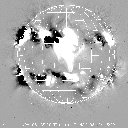
We have started routinely looking at daily difference images, something
that we should have done long ago. The Yohkoh data come in daily
sets as the Earth, carrying the Kagoshima ground station, rotates underneath
its orbit. One day thus is a natural unit for difference-image searches.
One motivation for this would be to spot emerging flux as it happens, in
order to guide observations of new regions. An example appears below:

This particular difference pair was selected to show some interesting
phenomena. It looks rather ugly (hence the title) because we have not corrected
for solar rotation - thus new things or brightening things show
up as white, whereas old things or dimming things show up as black.
Newly emerging flux would be white. The gray-scale is saturated to show
faint things; the original images have extremely large dynamic range because
they are composed from pairs of long and short exposures. We show the same
image below with a heliographic grid for reference, and call out several
items. The grid lines are at the usual 15-degree increments; N up and W
to the right.

The differences show many other things, and we intend to develop this tool for routine monitoring. Of course, dimming resulting from a CME occurrence would be nice to be able to sense routinely, but this effect is quite subtle and would be difficult to detect with relatively hideous images such as these.